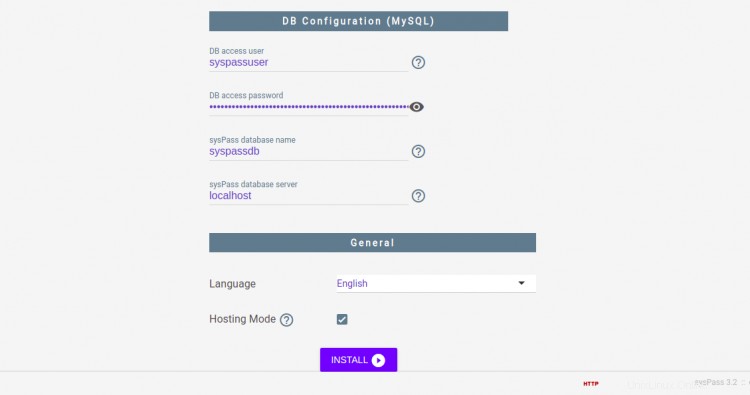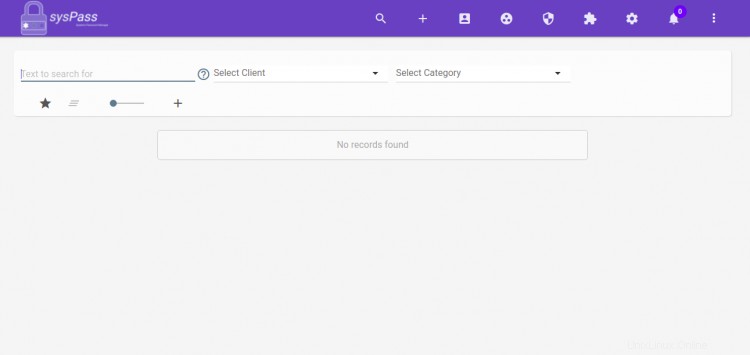sysPass è un'applicazione di gestione delle password basata sul Web scritta in PHP. È sicuro, affidabile e funziona in un ambiente multiutente per uso aziendale e personale. Salva le password utilizzando la crittografia bidirezionale con una password principale in un database. Fornisce un'interfaccia utente Web intuitiva che ti aiuta a impostare opzioni come autenticazione LDAP, posta, controllo, backup, importazione/esportazione, ecc.
Caratteristiche
- Gratuito e open source
- Controllo accessi gruppo/profilo
- Crittografia password
- Archiviazione file con visualizzatore di immagini in linea
- Integrazione OpenLDAP e Active Directory
- Fornire una notifica via e-mail
In questo tutorial, ti mostrerò come installare l'applicazione di gestione password sysPass e proteggerla con un certificato SSL Let's Encrypt gratuito su Debian 11.
Prerequisiti
- Un server che esegue Debian 11.
- Un nome di dominio valido puntato all'IP del tuo server.
- Sul server è configurata una password di root.
Installa Apache, MariaDB e PHP
sysPass funziona su server web, utilizza MariaDB come backend di database e scritto in PHP. Quindi dovrai installare il server web Apache, il server di database MariaDB, PHP e altre estensioni PHP sul tuo server. Puoi installarli tutti usando il seguente comando:
apt-get install apache2 mariadb-server libapache2-mod-php php php-mysqli php-pdo php-pear php php-cgi php-cli php-common php-gd php-json php-readline php-curl php-intl php-ldap php-xml php-mbstring git -y
Una volta installati tutti i pacchetti, modifica il file php.ini e apporta alcune modifiche:
nano /etc/php/7.4/apache2/php.ini
Modifica le seguenti impostazioni:
post_max_size = 100M upload_max_filesize = 100M max_execution_time = 7200 memory_limit = 512M date.timezone = Asia/Kolkata
Salva e chiudi il file quando hai finito. Quindi, riavvia il servizio Apache per applicare le modifiche alla configurazione:
systemctl restart apache2
Crea un database per sysPass
Per impostazione predefinita, l'installazione di MariaDB non è protetta. Quindi dovrai prima proteggerlo. Puoi proteggerlo usando il seguente comando:
mysql_secure_installation
Rispondi a tutte le domande come mostrato di seguito per impostare una password di root MariaDB e proteggere l'installazione:
Enter current password for root (enter for none): Switch to unix_socket authentication [Y/n] Y Change the root password? [Y/n] Y New password: Re-enter new password: Remove anonymous users? [Y/n] Y Disallow root login remotely? [Y/n] Y Remove test database and access to it? [Y/n] Y Reload privilege tables now? [Y/n] Y
Una volta terminato, accedi all'interfaccia di MariaDB con il seguente comando:
mysql -u root -p
Ti verrà chiesto di fornire una password di root MariaDB. Una volta effettuato l'accesso, crea un database e un utente con il seguente comando:
MariaDB [(none)]> create database syspassdb;
MariaDB [(none)]> grant all privileges on syspassdb.* to [email protected] identified by "password";
Quindi, svuota i privilegi ed esci dalla shell MariaDB con il seguente comando:
MariaDB [(none)]> flush privileges;
MariaDB [(none)]> exit;
A questo punto, il tuo database MariaDB e l'utente sono pronti per sysPass. Ora puoi procedere al passaggio successivo.
Installa sysPass
Innanzitutto, dovrai scaricare l'ultima versione di sysPass dal repository Git. Puoi scaricarlo usando il seguente comando:
git clone https://github.com/nuxsmin/sysPass.git
Una volta completato il download, sposta la directory scaricata nella directory principale web di Apache:
mv sysPass /var/www/html/syspass
Quindi, imposta la proprietà corretta sulla directory syspass con il comando seguente:
chown -R www-data:www-data /var/www/html/syspass
Quindi, imposta l'autorizzazione corretta per le altre directory:
chmod 750 /var/www/html/syspass/app/{config,backup} Successivamente, dovrai installare Composer sul tuo sistema.
Innanzitutto, crea uno script di installazione di Composer con il seguente comando:
nano /var/www/html/syspass/install-composer.sh
Aggiungi le seguenti righe:
#!/bin/sh
EXPECTED_SIGNATURE="$(wget -q -O - https://composer.github.io/installer.sig)"
php -r "copy('https://getcomposer.org/installer', 'composer-setup.php');"
ACTUAL_SIGNATURE="$(php -r "echo hash_file('sha384', 'composer-setup.php');")"
if [ "$EXPECTED_SIGNATURE" != "$ACTUAL_SIGNATURE" ]
then
>&2 echo 'ERROR: Invalid installer signature'
rm composer-setup.php
exit 1
fi
php composer-setup.php --quiet
RESULT=$?
rm composer-setup.php
exit $RESULT
Salva e chiudi il file, quindi esegui lo script di installazione di Composer utilizzando il comando seguente:
cd /var/www/html/syspass/
sh install-composer.sh
Una volta installato Composer, esegui il comando seguente per installare tutte le dipendenze PHP richieste:
php composer.phar install --no-dev
Una volta installate tutte le dipendenze, puoi procedere al passaggio successivo.
Configura l'host virtuale Apache per sysPass
Successivamente, dovrai creare un file di configurazione dell'host virtuale Apache per ospitare sysPass su Internet. Puoi crearlo usando il seguente comando:
nano /etc/apache2/sites-available/syspass.conf
Aggiungi le seguenti righe:
<VirtualHost *:80> ServerAdmin [email protected] DocumentRoot "/var/www/html/syspass" ServerName syspass.example.com <Directory "/var/www/html/syspass/"> Options MultiViews FollowSymlinks AllowOverride All Order allow,deny Allow from all </Directory> TransferLog /var/log/apache2/syspass_access.log ErrorLog /var/log/apache2/syspass_error.log </VirtualHost>
Salva e chiudi il file quando hai finito di attivare l'host virtuale Apache con il seguente comando:
a2ensite syspass
Quindi, riavvia il servizio Apache per applicare le modifiche:
systemctl restart apache2
Puoi anche controllare lo stato del servizio Apache usando il seguente comando:
systemctl status apache2
Dovresti ottenere il seguente output:
? apache2.service - The Apache HTTP Server
Loaded: loaded (/lib/systemd/system/apache2.service; enabled; vendor preset: enabled)
Active: active (running) since Sat 2021-10-16 13:41:36 UTC; 4s ago
Docs: https://httpd.apache.org/docs/2.4/
Process: 17819 ExecStart=/usr/sbin/apachectl start (code=exited, status=0/SUCCESS)
Main PID: 17824 (apache2)
Tasks: 6 (limit: 2341)
Memory: 14.7M
CPU: 76ms
CGroup: /system.slice/apache2.service
??17824 /usr/sbin/apache2 -k start
??17825 /usr/sbin/apache2 -k start
??17826 /usr/sbin/apache2 -k start
??17827 /usr/sbin/apache2 -k start
??17828 /usr/sbin/apache2 -k start
??17829 /usr/sbin/apache2 -k start
Oct 16 13:41:36 debian11 systemd[1]: Starting The Apache HTTP Server...
Una volta terminato, puoi procedere al passaggio successivo.
Accedi all'interfaccia utente Web di sysPass
A questo punto, sysPass è installato e ospitato sul server web Apache. Ora apri il tuo browser web e accedi all'interfaccia web di sysPass utilizzando l'URL http://syspass.example.com . Verrai reindirizzato alla seguente pagina:


Fornisci il tuo nome utente amministratore, password, password principale, credenziali del database, scegli la lingua, la modalità di hosting e fai clic su INSTALLA pulsante. Una volta completata l'installazione, verrai reindirizzato alla pagina di accesso di sysPass.

Fornisci il nome utente e la password dell'amministratore e fai clic su > pulsante. Dovresti vedere la dashboard di sysPass nella pagina seguente:

Abilita Let's Encrypt SSL Support su sysPass
È sempre una buona idea proteggere il tuo sito Web con Let's Encrypt SSL. Innanzitutto, dovrai installare il client Certbot per installare e gestire SSL. Per impostazione predefinita, il pacchetto Certbot è incluso nel repository predefinito di Debian 11, quindi puoi installarlo con il seguente comando:
apt-get install python3-certbot-apache -y
Una volta installato Certbot, esegui il comando seguente per proteggere il tuo sito Web con Let's Encrypt SSL:
certbot --apache -d syspass.example.com
Ti verrà chiesto di fornire la tua email e di accettare i termini del servizio come mostrato di seguito:
Saving debug log to /var/log/letsencrypt/letsencrypt.log Plugins selected: Authenticator standalone, Installer None Enter email address (used for urgent renewal and security notices) (Enter 'c' to cancel): [email protected] - - - - - - - - - - - - - - - - - - - - - - - - - - - - - - - - - - - - - - - - Please read the Terms of Service at https://letsencrypt.org/documents/LE-SA-v1.2-November-15-2017.pdf. You must agree in order to register with the ACME server at https://acme-v02.api.letsencrypt.org/directory - - - - - - - - - - - - - - - - - - - - - - - - - - - - - - - - - - - - - - - - (A)gree/(C)ancel: A - - - - - - - - - - - - - - - - - - - - - - - - - - - - - - - - - - - - - - - - Would you be willing to share your email address with the Electronic Frontier Foundation, a founding partner of the Let's Encrypt project and the non-profit organization that develops Certbot? We'd like to send you email about our work encrypting the web, EFF news, campaigns, and ways to support digital freedom. - - - - - - - - - - - - - - - - - - - - - - - - - - - - - - - - - - - - - - - - (Y)es/(N)o: Y Plugins selected: Authenticator apache, Installer apache Obtaining a new certificate Performing the following challenges: http-01 challenge for syspass.example.com Enabled Apache rewrite module Waiting for verification... Cleaning up challenges Created an SSL vhost at /etc/apache2/sites-available/syspass-le-ssl.conf Enabled Apache socache_shmcb module Enabled Apache ssl module Deploying Certificate to VirtualHost /etc/apache2/sites-available/syspass-le-ssl.conf Enabling available site: /etc/apache2/sites-available/syspass-le-ssl.conf
Quindi, seleziona se reindirizzare o meno il traffico HTTP su HTTPS come mostrato di seguito:
Please choose whether or not to redirect HTTP traffic to HTTPS, removing HTTP access. - - - - - - - - - - - - - - - - - - - - - - - - - - - - - - - - - - - - - - - - 1: No redirect - Make no further changes to the webserver configuration. 2: Redirect - Make all requests redirect to secure HTTPS access. Choose this for new sites, or if you're confident your site works on HTTPS. You can undo this change by editing your web server's configuration. - - - - - - - - - - - - - - - - - - - - - - - - - - - - - - - - - - - - - - - - Select the appropriate number [1-2] then [enter] (press 'c' to cancel): 2
Digita 2 e premi Invio per installare Let's Encrypt SSL per il tuo sito web:
Enabled Apache rewrite module Redirecting vhost in /etc/apache2/sites-enabled/syspass.conf to ssl vhost in /etc/apache2/sites-available/syspass-le-ssl.conf - - - - - - - - - - - - - - - - - - - - - - - - - - - - - - - - - - - - - - - - Congratulations! You have successfully enabled https://syspass.example.com You should test your configuration at: https://www.ssllabs.com/ssltest/analyze.html?d=syspass.example.com - - - - - - - - - - - - - - - - - - - - - - - - - - - - - - - - - - - - - - - - IMPORTANT NOTES: - Congratulations! Your certificate and chain have been saved at: /etc/letsencrypt/live/syspass.example.com/fullchain.pem Your key file has been saved at: /etc/letsencrypt/live/syspass.example.com/privkey.pem Your cert will expire on 2021-07-20. To obtain a new or tweaked version of this certificate in the future, simply run certbot again with the "certonly" option. To non-interactively renew *all* of your certificates, run "certbot renew" - If you like Certbot, please consider supporting our work by: Donating to ISRG / Let's Encrypt: https://letsencrypt.org/donate Donating to EFF: https://eff.org/donate-le
Conclusione
Congratulazioni! hai installato correttamente sysPass password manager con Apache su Debian 11. Ora puoi creare un account diverso, aggiungere utente, privilegi di accesso e distribuirlo nel tuo ambiente di produzione.